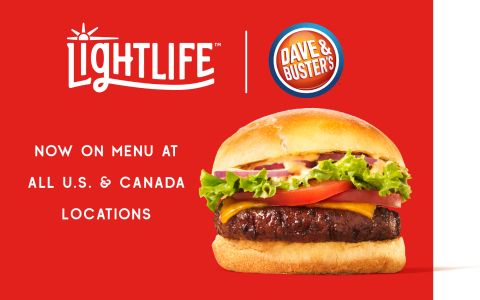DAVE & BUSTER’S INTRODUCES LIGHTLIFE MEATLESS BURGER – WHERE DOES MEATLESS TREND STAND?
BEYOND MEAT, Impossible Burger, LIGHTLIFE BURGER
Beyond Meat and Impossible Foods have gotten most of the attention with their meatless burgers while large companies such as Tyson Foods are no doubt working feverishly to complete their competitive product development. The latest announcement in this area , today, is that Dave & Buster’s has introduced their Lightlife Burger, a plant based product with which we were admittedly not familiar. We wrote an article back on June 4th, provided at the end of this update. At that point, Beyond Meat stock (BYND) had more than quadrupled in the five weeks following its IPO at $25.00 per share. A lot has happened since June 4th. Burger King rolled out The Impossible Burger systemwide, Tim Horton tested it in Canada and has pulled it back, for whatever combination of reasons. McDonald’s announced on 9/27 that they are going to test a Beyond Meat product in Canada. A number of other public chains have introduced meatless beef and chicken products.
Beyond Meat stock (BYND) went from 104 when we wrote on June 4th to a high above $230 by the end of July, retreated steadily to $135 by the end of September, spiked briefly twenty points on the McDonald’s announcement at the end of September, and has slipped steadily to a new low of $118 today. At $118, the enterprise value is still $7.2 billion. According to Bloomberg, sales are projected at $261M in 2019 and $415M in 2020. EPS is projected at a loss of $0.26 of 2019 and a profit of $0.23 in 2020. I’ll make it easy for you. The stock is selling at over FIVE HUNDRED TIMES 2020 projected earnings per share.
Back to the Lightlife Burger: The nutritional content is about the same as the Impossible and Beyond Meat products. The calorie counts, compared to a regular burger are about the same, the fat content is about the same, there is no cholesterol (that’s good), the sodium content , at 540mg is more than five times that of a regular burger (that’s bad) and even more than the 400 mg of Impossible and Beyond. We called Dave & Buster’s (at Palisades Center) and they are charging $16.99 for the Lightlife product (with fries no doubt) versus $13.99 for the normal burger platter. That’s a 21 percent premium, an obviously material detriment. This is in our opinion, far from a game changer (no pun intended) for Dave & Buster’s.
The largest QSR exposure of the Impossible Burger has been at Burger King over the last several months. Prior to the systemwide rollout in August, BK stated that traffic was up 18.5% in a 29 day test in St.Louis. We can assure you that nothing like that is happening since the product has been rolled out systemwide, or management of Restaurant Brands stock would have let us know. Our guess is that BK comp sales are running no more than a couple of points better than prior trends.
In short: we stand by our previous conclusion, hereby restated. Our complete discussion of June 4th is provided below.
CONCLUSION – copied from 6/4/19
The unanswered question is: how large is the demand, at restaurants, for a product that costs more, has the same calorie count and fat content, has a lot more sodium (which creates high blood pressure), but has no cholesterol and contains useful elements such as Thiamin (which helps with nerve, muscle and heart function), B12 (helps with fatigue) and Zinc (for prostate health)?
We do not expect the introduction of meatless products to restaurant menus to improve sales in any meaningful way. The new meatless products taste fine, by all reports, but we haven’t heard anyone say that they taste “better”, and help to justify a higher price. The long term health benefits as described just above are too subtle for most restaurant customers to care much about. Just look at the size, and the nutritional values, of the portions at Cheesecake Factory, Cracker Barrel, and almost everyone else. This, too, in terms of stock market excitement and restaurant industry focus, shall pass.
ENTIRE ARTICLE – AS OF 6/4/19
THE “IMPOSSIBLE BURGER” – HOW WILL IT IMPACT THE RESTAURANT INDUSTRY?
We have all been reading, for weeks now, about the huge potential for meatless food products. Beyond Meats (BYND) came public five weeks ago (5/1/19) at $25.00 per share and has gone up a cool four times in value. The total market value of BYND is about $6 billion, and the company is expected to generate (according to Bloomberg) $205M of sales in 2019 (up from $88M in 2018), then $335M in 2020. Profits are nonexistent, having lost $4.56/share in 2018, still expected to lose $0.40/share in 2019, then lose $0.18 in 2020. Safe to say that BYND common stock is trading several years ahead of the fundamentals. This is not unusual, however, when rapidly growing companies have caught investors’ fancy.
The other prominent supplier of plant based meat products is Impossible Foods, which has introduced a variety of products, including the widely promoted Impossible Burger. Impossible Foods is privately held, so we don’t know what their revenues and profits look like, but they recently raised $300 million and have reportedly raised a total approximating $750 million since the founding in 2011.
There have been couple of noteworthy announcements from public companies relating to meatless products. (1) A small company called Chanticleer Holdings (BURG), which operates several burger based concepts, announced on 5/8 (a week after BYND came public) a partnership with BYND, where Beyond Meat burgers will be offered at Chanticleer various brands. That day, May 8th, BURG stock ran from about $1.48/share to almost $3.00 per share, with almost 15 million shares trading. It closed that day at $1.94 and has drifted lower ever since to an all time low around $1.00 per share. (2) Restaurant Brands (QSR) announced on April 1st that their 59 Burger King restaurants in and around St.Louis were going to start serving the Impossible Burger. After reporting that the St.Louis test generated an 18% traffic gain in April, QSR announced on May 14th that they were introducing the Impossible Burger into three new markets, Miami FL, Columbus GA and Montgomery AL. While noone is suggesting that an 18% gain in traffic is to be expected, BMO analyst Peter Sklar wrote on 5/22 that Burger King’s same store sales could be increased by 450 basis points with a national rollout by yearend. For what it’s worth, QSR stock was trading around $65 on April 1st (with the first announcement), around $67 in mid May when the additional three markets was announced, at about $68 when BMO provided their expectation, and at about $65. today. To be sure, there are a lot of moving parts at QSR, other than Burger King, and apparently Tim Horton’s is not doing as well as expected right now. Again, for whatever its worth, and for whatever combination of reasons, CEO, Jose Cil sold $8.7M of his shares on May 28th, at $68.28 per share, about 17 percent of his holdings. This would probably not imply that the Impossible Burger was going to shake (or shock) the world at Burger King.

THE MARKETPLACE VERDICT
Aside from the skyrocketing stock price of Beyond Meats, the marketplace verdict relative to Restaurant Brands and Chanticleer Holdings (an admittedly very small sample) is that the Impossible Burger is not a game changer. One obvious reason is that no single restaurant company will have an exclusive on meatless burgers. In fact: White Castle, TGI Fridays, Del Taco Restaurants, Carl’s Jr. and Red Robin Gourmet Burgers have all introduced Beyond Meat and Impossible Foods products over the past 18 months. We haven’t heard shockingly good sales or traffic numbers from any of these chains. If there is substantial long term demand, everyone will offer it and noone will have a competitive edge.
OUR LONGER TERM VIEW
It is unclear how many new customers will choose one restaurant over another based on a meatless alternative. It is already clear that the cost of goods per unit for the meatless product is higher, so the menu price will be higher as well. It is unclear to us how many consumers are prepared to pay more, especially when (1) the calorie count is the virtually the same and (2) the fat content is approximately the same. We will detail shortly more specifics about nutritional comparisons, but we believe that calorie count and fat content are the two nutritional elements that customers will care about, if they care at all. We have our doubts about how well educated, relative to nutritional considerations, the consuming public is. The average American is twenty five pounds heavier over the last thirty years, and there is a monstrous amount of fried chicken, french fried potatoes, and cheesecake consumed. Also, we are not aware that the addition of calorie counts to menus has changed consumer menu choices. Before we wrap up this discussion, here are more nutritional comparisons of the two products.
A quarter pound beef patty has 260 calories, the Impossible Burger 240. A patty has 22g grams of fat, the IB also 22g. A patty as 94 mg of cholesterol, an IB zero. A patty has 89mg of sodium (4% of the Daily Value), an IB has 370mg (16% DV)(not so good). A patty has no Thiamin, and the IB has 2350% of the DV (that’s good). A patty has no B12 and an IB has 130% of the DV (that’s good). A patty has no Zinc and the IB has 50% of the DV (that’s good).
CONCLUSION
The unanswered question is: how large is the demand, at restaurants, for a product that costs more, has the same calorie count and fat content, has a lot more sodium (which creates high blood pressure), but has no cholesterol and contains useful elements such as Thiamin (which helps with nerve, muscle and heart function), B12 (helps with fatigue) and Zinc (for prostate health)?
We do not expect the introduction of meatless products to restaurant menus to improve sales in any meaningful way. The new meatless products taste fine, by all reports, but we haven’t heard anyone say that they taste “better”, and help to justify a higher price. The long term health benefits as described just above are too subtle for most restaurant customers to care much about. Just look at the size, and the nutritional values, of the portions at Cheesecake Factory, Cracker Barrel, and almost everyone else. This, too, in terms of stock market excitement and restaurant industry focus, shall pass.
Roger Lipton
==========================
About Roger Lipton
Roger is an investment professional with over 4 decades of experience specializing in chain restaurants and retailers, as well as macro-economic and monetary developments. After earning a BSME from R.P.I. and MBA from Harvard, and working as an auditor with Price, Waterhouse, he began following the restaurant industry as well as the gold mining industry. While he originally followed companies such as Church’s Fried Chicken, Morrison’s Cafeterias and others, over the years he invested in companies such as Panera Bread and shorted companies such as Boston Chicken (as described in Chain Leader Magazine)
https://finance.yahoo.com/news/dave-buster-upgrades-lightlife-burger-110000748.html


